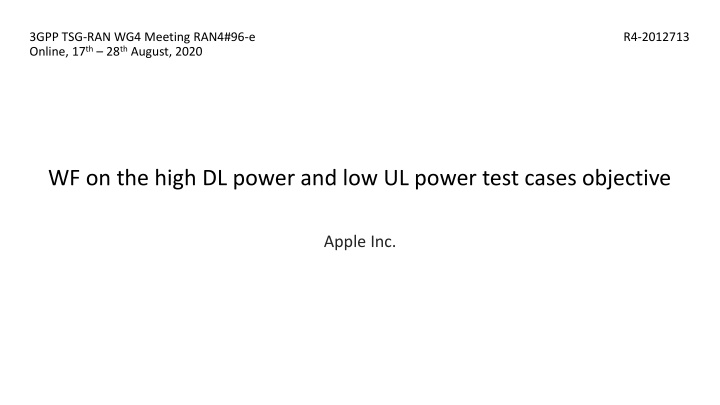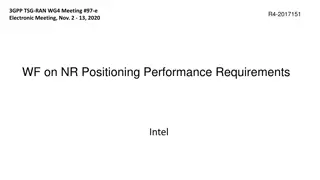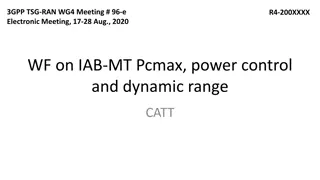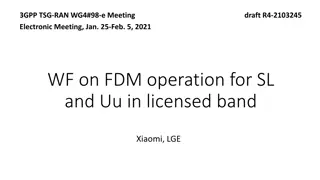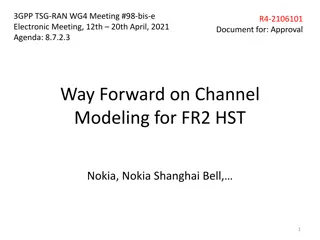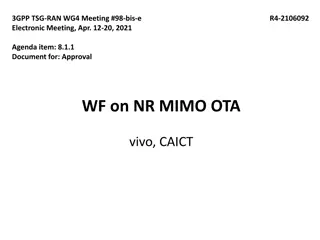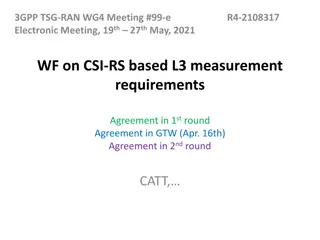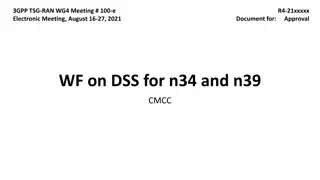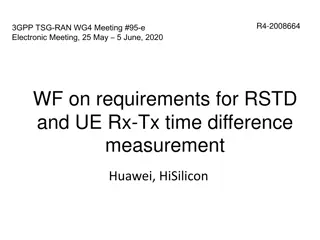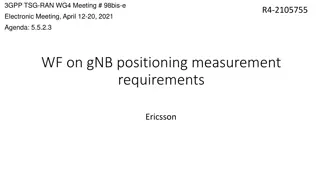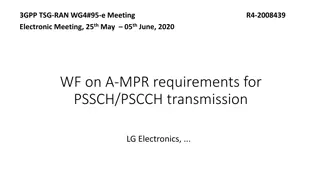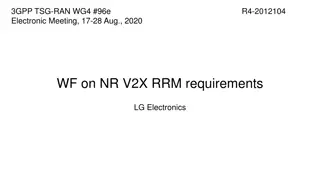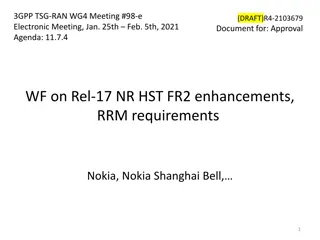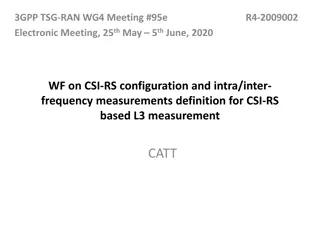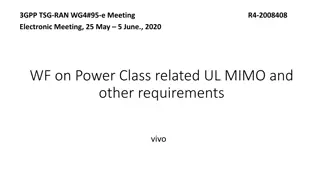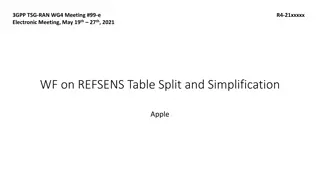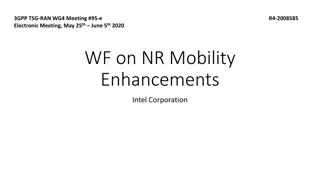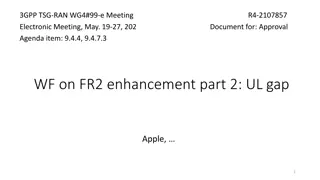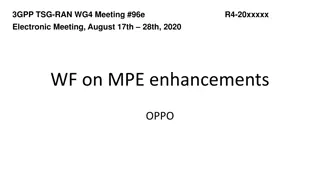Advanced Test System Enhancements Discussion at 3GPP TSG-RAN-WG4 Meeting
Investigate enhancements to non-permitted and permitted test systems for high DL power and low UL power test cases. Focus on vendor declarations, UE beam management sensitivity, and methodology improvements. Discussion includes proposals for test setup, impact on test time, and preliminary measurements.
Download Presentation

Please find below an Image/Link to download the presentation.
The content on the website is provided AS IS for your information and personal use only. It may not be sold, licensed, or shared on other websites without obtaining consent from the author.If you encounter any issues during the download, it is possible that the publisher has removed the file from their server.
You are allowed to download the files provided on this website for personal or commercial use, subject to the condition that they are used lawfully. All files are the property of their respective owners.
The content on the website is provided AS IS for your information and personal use only. It may not be sold, licensed, or shared on other websites without obtaining consent from the author.
E N D
Presentation Transcript
3GPP TSG-RAN WG4 Meeting RAN4#96-e Online, 17th 28th August, 2020 R4-2012713 WF on the high DL power and low UL power test cases objective Apple Inc.
EnhancedSpecialized test systems Investigate non-permitted test systems, such that the test case applicability of these test systems under investigations is according to WF in R4- 1913070 (i.e. such test systems are not required to verify all requirements in TS38.101-2). The list of candidate non-permitted test systems is limited to NFTF and DNF NF based solutions Whether non-permitted test systems under investigation shall be capable of beam peak search and spherical coverage evaluation is FFS. For non-permitted test systems under investigation, text proposals on test setup descriptions, gains from the enhancements relative to permitted methods in TR38.810, impact on test time, and preliminary MU are needed for the next RAN4 meeting.
Enhancements to permitted methods For the permitted methods in TR38.810, text proposals on test setup descriptions, gains from the enhancements relative to permitted methods in TR38.810, impact on test time, and preliminary MU are needed for the next RAN4 meeting. If no such proposals are submitted by the next RAN4 meeting, then RAN4 agrees that no enhancement of permitted methods is feasible.
Manufacturer declarations The list of potential candidate vendor declarations and how they map to a particular test system parameter includes the following: Location of the active panels that yields the TX and RX beam peaks (applicable if the enhanced test methodology does not need to perform beam peak search) Location of the active panels in any UL/DL test direction and the detailed locations of the panels within the DUT (applicable if the enhanced test methodology does need to perform beam peak search) Whether vendor declarations can be restricted to test cases based on single direction is FFS (to be determined next RAN4 meeting) Whether vendor declarations, based on the above proposals, can be adopted as methodology enhancements is FFS (to be determined next RAN4 meeting)
Study of UE beam management sensitivity to magnitude/phase variation of the DL signal If beam peak direction and UBF activation are performed based on FF method and then perform other TCs based on NF method, then the beam management study is not necessary. For the DNF system, and assuming it needs to perform beam peak search, such that the DUT is enabled to form its UL beam in the direction of the DL signal, a study of UE beam management sensitivity to magnitude/phase variation of the DL signal needed. Simulation assumptions are provided in the following slides
Antenna Assumptions for Rel-15 in TR38.810 G.3 Spherical coverage Measurement Grids G.3.1 Assumptions The simulation assumptions for the spherical coverage grids are the same as outlined in Annex G.1.1. Regarding the antenna implementation and beamformer, the following assumptions have been made (refer to Figure G.3.1-1): Two 8x2 antenna arrays are integrated in the UE for the spherical coverage analyses The implementation loss for the antenna near the front is 5dB less than that for the antenna near the back For Beam Steering Assumptions In the xz plane, 45o beam steering granularity (from 45o to 135o) has been used In the xy plane, 22.5o beam steering granularity (from -90o to 90o) has been used No offset antennas Figure G.3.1-1: Illustration of the two antenna arrays integrated in the UE.
z yoffset New Antenna Assumptions for Rel-17 Enh Test SI Front zoffset G.3 G.3.1 Assumptions The simulation assumptions for the spherical coverage grids are the same as outlined in Annex G.1.1 in TR38.810. Regarding the antenna implementation and beamformer, the following assumptions have been made (refer to Figure G.3.1-1 in TR38.810): Two antenna arrays are integrated in the UE for the spherical coverage analyses Antenna panels are studied with Nz x Ny with Nz>Ny, e.g., 8x2 corresponds to Nz = 8 and Ny = 2 The implementation loss for the antenna near the front is 0dB less than that for the antenna near the back The antenna in the back is on the opposite side of the UE (mirrored around (0,0,0)). For Beam Steering Assumptions In the xy plane, assume 45o beam steering granularity (AZ from -45o to +45o) In the xz plane, assume 22.5o beam steering granularity (EL from -90o to 90o) Front and back figures in this page are example positions of two antenna arrays Spherical coverage Measurement Grids y x Back Illustration of the two antenna arrays integrated in the UE, for Rel-17 simulation
New Simulation Assumptions for Rel-17 Enh Test SI Offsets: Various antenna offsets (yoffset, zoffset) beyond 7.5cm in radius (12.5cm max) Offset is defined with respect to the center of antenna array Antenna Array: 8x2 and 4x1 Range Lengths (distance between centre of QZ/positioning axes and measurement probe): 30cm, 20m (more range lengths are not precluded) Goal is to eventually determine min. range length and MU for performing spherical coverage tests in DNF Test Methodology: DNF (while taking path loss offsets into account) Sampling Grid: Study finer than 7.5deg step size for constant-step size grids (both MVG/Sony and KS agree to parametric studies to show convergence for the selected assumption)
Path loss comparison across system types The path loss comparison across IFF/DFF and NF system types below is taken as a starting point, and companies are encouraged to bring proposals to the next RAN4 meeting with corrections and/or improvements Antenna Config. 1, 2, and 3 - BLACK BOX - (PC3 Devices: D=5cm) Antenna Config. 1 and 2 - WHITE BOX - (PC3 Devices: D=5cm) IFF/DFF NF DFF NF f [GHz] Path Loss with 1m range length 60.16 62.01 64.51 65.24 66.89 Path Loss with 0.22m range length 46.86 48.71 51.21 51.94 53.59 Path Loss with 0.88m range length Path Loss with 0.28m range length 59.01 60.85 63.35 64.08 65.73 48.93 50.78 53.28 54.00 55.65 24.25 30 40 43.5 52.6
References Ref T-doc number Title Company Remaining issues with the test methodology for high DL power and low UL power test cases Summary and Further Results on Impact of phase variation on beam pattern for NF test method On Test methodology for high DL power and low UL power test cases Views on test methods for high DL power and low UL power TCs FR2 testability enhancement for UE emissions Email discussion summary for [96e][330] FR2_enhTestMethods [1] R4-2009960 Apple Inc. [2] R4-2010856 MVG Industries, Sony [3] R4-2011218 Keysight Technologies [4] R4-2011281 Rohde & Schwarz [5] R4-2011456 Qualcomm Incorporated [6] R4-2012561 Moderator (Apple Inc.)
